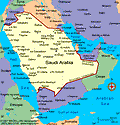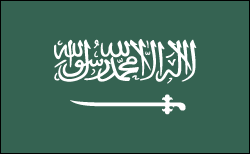Saudi Arabia
| Facts & Figures |
|---|
|
Sovereign: King Abdullah (2005) Land area: 829,995 sq mi (2,149,690 sq km) Population (2010 est.): 29,207,277 (growth rate: 1.7%); birth rate: 28.2/1000; infant mortality rate: 11.2/1000; life expectancy: 76.5; density per sq mi: 33 Other large cities: Jeddah, 2,745,000; Makkah (Mecca), 1,614,800 Monetary unit: Riyal |
Geography
Saudi Arabia occupies most of the Arabian Peninsula, with the Red Sea and the Gulf of Aqaba to the west and the Persian Gulf to the east. Neighboring countries are Jordan, Iraq, Kuwait, Qatar, the United Arab Emirates, the Sultanate of Oman, Yemen, and Bahrain, connected to the Saudi mainland by a causeway. Saudi Arabia contains the world's largest continuous sand desert, the Rub Al-Khali, or Empty Quarter. Its oil region lies primarily in the eastern province along the Persian Gulf.
Government
Saudi Arabia was an absolute monarchy until 1992, at which time the Saud royal family introduced the country's first constitution. The legal system is based on the sharia (Islamic law).
History
Saudi Arabia is not only the homeland of the Arab peoples—it is thought that the first Arabs originated on the Arabian Peninsula—but also the homeland of Islam, the world's second-largest religion. Muhammad founded Islam there, and it is the location of the two holy pilgrimage cities of Mecca and Medina. The Islamic calendar begins in 622, the year of the hegira, or Muhammad's flight from Mecca. A succession of invaders attempted to control the peninsula, but by 1517 the Ottoman Empire dominated, and in the middle of the 18th century, it was divided into separate principalities. In 1745 Muhammad ibn 'Abd al-Wahhab began calling for the purification and reform of Islam, and the Wahhabi movement swept across Arabia. By 1811, Wahhabi leaders had waged a jihad—a holy war—against other forms of Islam on the peninsula and succeeded in uniting much of it. By 1818, however, the Wahhabis had been driven out of power again by the Ottomans and their Egyptian allies.
The kingdom of Saudi Arabia is almost entirely the creation of King Ibn Saud (1882–1953). A descendant of Wahhabi leaders, he seized Riyadh in 1901 and set himself up as leader of the Arab nationalist movement. By 1906 he had established Wahhabi dominance in Nejd and conquered Hejaz in 1924–1925. The Hejaz and Nejd regions were merged to form the kingdom of Saudi Arabia in 1932, which was an absolute monarchy ruled by sharia. A year later the region of Asir was incorporated into the kingdom.
The Discovery of Oil and Political Evolution
Oil was discovered in 1936, and commercial production began during World War II. This oil-derived wealth allowed the country to provide free health care and education while not collecting any taxes from its people. Saudi Arabia was neutral until nearly the end of the war, but it was permitted to be a charter member of the United Nations. The country joined the Arab League in 1945 and took part in the 1948–1949 war against Israel. Saudi Arabia still does not recognize the state of Israel. On Ibn Saud's death in 1953, his eldest son, Saud, began an 11-year reign marked by an increasing hostility toward the radical Arabism of Egypt's Gamal Abdel Nasser. In 1964, the ailing Saud was deposed and replaced by the prime minister, Crown Prince Faisal, who gave vocal support but no military help to Egypt in the 1967 Arab-Israeli War.
Faisal's assassination by a deranged kinsman in 1975 shook the Middle East, but it failed to alter his kingdom's course. His successor was his brother, Prince Khalid. Khalid gave influential support to Egypt during negotiations on Israeli withdrawal from the Sinai Desert. King Khalid died of a heart attack in 1982, and he was succeeded by his half-brother, Prince Fahd bin 'Abdulaziz, who had exercised the real power throughout Khalid's reign. King Fahd chose his half-brother Abdullah as crown prince.
Saudi Arabia and the smaller oil-rich Arab states on the Persian Gulf, fearful that they might become Ayatollah Ruhollah Khomeini's next targets if Iran conquered Iraq, made large financial contributions to the Iraqi war effort during the 1980s. At the same time, cheating by other members of the Organization of Petroleum Exporting Countries (OPEC), competition from nonmember oil producers, and conservation efforts by consuming nations combined to drive down the world price of oil. At the time Saudi Arabia had one-third of all known oil reserves, but falling demand and rising production outside OPEC combined to reduce its oil revenues from $120 billion in 1980 to less than $25 billion in 1985, threatening the country with domestic unrest and undermining its influence in the Gulf area.
At the start of 1996, King Fahd passed authority to Crown Prince Abdullah, after suffering an incapacitating stroke. In 1998 the country's oil income fell by 40% because of a worldwide decline in prices, and it entered its first recession in six years.
In 2000, Saudi Arabia, along with other OPEC nations experiencing a recession, decided to reduce production to raise oil prices. In 2001, OPEC cut oil production three additional times.
The Attacks of September 11, 2001, and Their Consequences
Saudi Arabia's relations with the U.S. were strained after the Sept. 11, 2001, terrorist attacks—15 of the 19 suicide bombers involved were Saudis. Despite the monarchy's close ties to the West, much of the extremely influential religious establishment has supported anti-Americanism and Islamic militancy. In Aug. 2003, following the U.S.-led war on Iraq in March and April 2003, the United States withdrew its troops stationed in Saudi Arabia. The U.S. had maintained troops in the country for the past decade, a source of great controversy in the strongly conservative Islamic country. One of the major reasons given for the Sept. 11 attacks by Saudi terrorist Osama bin Laden was the presence of U.S. troops in the home of Islam's holiest sites, Medina and Mecca. On May 12, 2003, suicide bombers killed 34, including 8 Americans, at housing compounds for Westerners in Riyadh. Al-Qaeda was suspected. Saudi Arabia's commitment to antiterrorist measures was again called into question by the U.S. and other countries. In July, the U.S. Congress bitterly criticized Saudi Arabia's alleged financing of terrorist organizations. While the Saudi government arrested a sizable number of suspected terrorists, little was done to quell Islamic militancy in the kingdom. Several attacks against Westerners took place in 2003 and 2004.
In Feb. 2005, Saudi Arabia held its first elections ever: municipal council elections to choose half of the new council members in Riyadh. The other half continued to be appointed, in keeping with the previous Saudi system. Women were not eligible to vote, and less than a third of eligible voters registered.
In Aug. 2005, King Fahd bin 'Abdulaziz died. His half-brother Abdullah, who had been the de facto ruler of the country for the past decade, assumed the throne.
Saudi Arabia brokered talks between the Afghan government and Taliban leaders in September 2008. In the talks, the first attempt to end the protracted armed conflict, the Taliban said it is severing ties to al-Qaeda.
King Shakes Up Government
King Abdullah took bold steps to reshuffle his government in February 2009, promoting reformers, firing controversial officials, including the conservative head of the religious police and the country's most senior judge, and appointing his first-ever female minister, for women's education.
Saudi Arabia was largely spared the popular uprisings that spread throughout the Middle East and Northern Africa in early 2011, largely because King Abdullah remains popular among Saudis and the country's oil wealth provides a level stability not seen in countries such as Egypt. Nevertheless, unemployment among young Saudis is high, housing is in short supply, and there has been a push for broader civil liberties, particularly for women. In an attempt to prevent protests on Saudi soil, Abdullah, upon returning to Saudi Arabia after spending three months in Morocco recovering from back surgery, announced a $10 billion aid package that helps Saudis buy homes, start businesses, and marry.
In September 2011, King Abdullah granted women the right to vote and run for seats on the Shura council, which advises the King on policy issues. The ruling will not go into effect until the next election cycle in 2015. Still, the decision is a significant victory for women in a country where they are not allowed to drive and must have a male chaperone with them in public at all times. Saudi Arabia is the only country in the world that has not granted women suffrage.


No comments:
Post a Comment